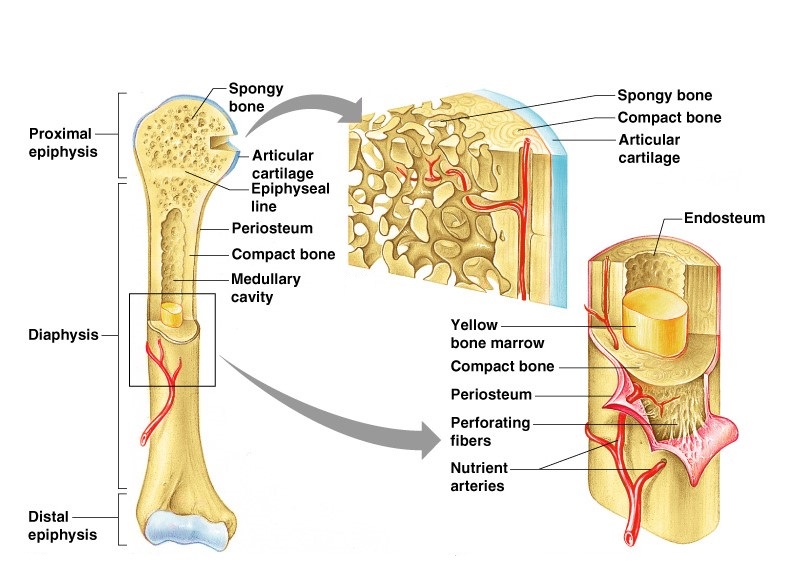
Gross anatomy of a typical long bone:
- Bone is a specialized connective tissue that has the strength of a cast iron and the lightness of pine wood.
- Our bone (osseous tissue) is a living tissue and contains only about 20% water.
- Most adult long bones have a tubular shaft called the diaphysis, which is a hollow cylinder with walls of compact bone tissue (deposition of calcium salts).
- The center of the cylinder is the medullary cavity or marrow cavity, which is filled with a marrow.
- At each end of the bone is a roughly spherical epiphysis of spongy bone tissue.
- The epiphysis is usually wider than the shaft.
- The metaphysis (which is made up of epiphyseal plate) separates the diaphysis from the epiphysis.
- The epiphyseal plates are the only places where long bones continue to grow in length after birth.
- The medullary cavity in the diaphysis consists of yellow marrow, which is mostly fat (adipose tissue).
- The porous lattice work of the epiphysis consists of red bone marrow, which manufactures the red blood cells.
- The lining of the medullary cavity of compact and spongy bone is the endosteum.
- The covering of the outer surface of the bone (except in the joint) is the periosteum.
- Periosteum is a fibrous membrane that has the potential to form bone during growth and in fracture healing.
- The periosteum contains nerves, lymphatic vessels and many capillaries that provide nutrients to the living bone.
- The compact bone consists of highly calcified cylindrical structures called osteons or Haversian systems.
- Osteocytes, osteoclasts, osteoblasts etc. are some of the cells present in our bones.

Some other skeletal connective tissues:
- Cartilage:
- Cartilage is a strong but flexible type of connective tissue found in our body.
- They are the outermost protective covering of the bones in the joints.
- They are not as strong as bones but are capable of supporting weight and giving rigid frameworks.
- They lack blood vessels.
- Outer covering of the cartilage is the perichondrium.
- Cartilages are of following 3 types:
- Hyaline cartilage: cartilages of the larynx and trachea in humans
- Fibrous cartilage: cartilages of intervertebral disk and pubic symphysis in pelvic girdle
- Elastic cartilage: cartilages of ear pinnae, epiglottis and Eustachian tube.

- Tendon:
- It is a flexible but inelastic cord of strong fibrous collagen tissue.
- Tendons attach a muscle to a bone.
- They are capable of withstanding tension.
- They help in locomotion and moving body parts.

- Ligament:
- Ligament is a short band of tough, flexible fibrous connective tissue.
- They are also made up of collagen.
- They connect two bones together in a joint.
Functions of bones:
The varied functions of bones may be classified as either mechanical or physiological.
- Mechanical functions of bones:
- Bones make up the skeleton and provide the rigid framework (proper shape) that supports our body.
- They protect the vulnerable and delicate internal organs by forming the sturdy walls of body cavities.
E.g. brain (protected by the cranium), spinal cord (by the vertebral column), heart and lungs (by the rib cage) and the organs of pelvis (by the pelvic girdle).
- They also make body movements possible by providing anchoring points for muscles and by acting as levers at the joints.
- Physiological functions of bones:
- Red bone marrow present in the medullary cavity of spongy bone manufactures red blood cells.
- Bones also maintain the blood calcium level by either absorbing calcium from blood or releasing calcium to the blood.